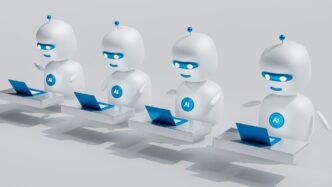The world of technology is always changing, and with it, the kinds of jobs people do. It’s not just about writing code anymore. There are so many different tech jobs out there, each needing different skills. This article looks at some of these jobs and what makes them important. We’ll explore how new tech like AI changes things and why staying up-to-date is key. We’ll also touch on making tech work for everyone and how remote work fits into all of this. It’s a big topic, but understanding these different tech jobs can help you see where you might fit in.
Key Takeaways
- The tech industry is growing and changing fast, with new jobs appearing all the time. Understanding these different tech jobs is important.
- AI and automation are changing many jobs, making some tasks easier but also requiring people to learn new skills.
- Making technology easy for everyone to use, no matter their abilities, is a growing area with specific job roles.
- Remote work offers flexibility and can make tech jobs more accessible to a wider range of people.
- Continuous learning is a must to keep up with new technologies and stay relevant in the job market.
Understanding The Evolving Tech Landscape

It feels like every day there’s a new gadget or a new way of doing things with computers. This whole digital revolution thing isn’t just about faster phones or fancier websites; it’s really changing what jobs are out there and what people need to know to do them. Think about it – things that used to take a whole team of people can now be done by a single program, or even just a smart algorithm. This means the skills that were important even a few years ago might not cut it anymore.
The biggest shift is how artificial intelligence is stepping in. It’s not just about crunching numbers anymore. AI can now write, create art, and even help diagnose problems. This is shaking up professions that we thought were pretty safe from automation. It’s like we’re in a constant race to keep up, and if you’re not learning new things, you can get left behind pretty quickly. It’s not just about coding either; it’s about understanding how these new tools work and how they fit into the bigger picture.
Here’s a look at some of the big forces at play:
- Automation of Routine Tasks: Many jobs that involve repetitive actions are being taken over by machines or software. This frees up people but also means those jobs might disappear.
- Rise of Cognitive AI: AI is now capable of tasks that require thinking and decision-making, impacting fields like customer service, content creation, and even some areas of research.
- New Job Creation: While some jobs are fading, entirely new roles are popping up, like people who specialize in talking to AI (prompt engineers) or those who make sure AI is used fairly (data ethicists).
This constant change means that learning isn’t a one-time thing anymore. It’s something you have to do all the time to stay relevant. It’s a bit daunting, sure, but it also opens up a lot of new possibilities if you’re willing to adapt.
Exploring Different Tech Jobs In Software Development
Software development is a huge field, and honestly, it’s where a lot of people first think of when they hear ‘tech job’. It’s not just about writing code all day, though. There’s a whole lot more to it than just that. Think about how apps and websites get made – it’s a process with different stages and different people doing different things.
Foundations Of Programming Concepts
Before you can build anything, you need to know the basics. This is like learning the alphabet before you can write a book. Programming languages all have common ideas, even if they look different on the surface. You’ve got things like variables, which are basically containers for information. Then there are loops, which let you repeat actions without typing them out a million times. And don’t forget conditional statements – these are the ‘if this, then that’ parts that make software smart. Understanding these core ideas means you can pick up new languages much faster. It’s the bedrock for everything else.
How Programming Languages Actually Work
So, you’ve got your code written in a language like Python or JavaScript. But how does the computer actually understand it? Well, most languages need to be translated. Some are compiled, meaning the whole code is turned into machine code (the computer’s native language) all at once before it runs. Think of it like translating an entire book before anyone reads it. Others are interpreted, where the code is translated line by line as it’s being executed. This is more like having a live translator for a conversation. Each approach has its pros and cons, affecting how fast the program runs and how easy it is to find mistakes.
Cross-Platform Development Tools And Strategies
These days, people use apps on all sorts of devices – phones, tablets, computers. Building a separate app for each one can be a ton of work. That’s where cross-platform development comes in. Tools like Tauri, Flutter, or React Native let developers write code once and have it run on multiple operating systems. It’s not always a perfect fit, and sometimes you trade a bit of performance for the convenience. But for many projects, it’s a smart way to get your software out to more people without doubling or tripling your effort. It’s all about finding the right balance for what you’re trying to build.
Accessibility And Inclusive Design In Technology

Designing For All Users
It’s easy to get caught up in the code, right? We focus on making things work, on features, on speed. But have you ever stopped to think about who’s actually using what you’re building? Truly great technology is built for everyone, not just the average user. This means thinking about people with different abilities from the very start. It’s not an afterthought; it’s a core part of good design. When we design with accessibility in mind, we’re not just ticking a box. We’re opening up our products and services to a wider audience, making them more usable, and frankly, just better.
Think about it: a clear, simple layout benefits everyone, not just someone with a visual impairment. Good color contrast helps people in bright sunlight just as much as someone with color blindness. It’s about making things intuitive and easy to interact with, no matter the situation.
The Power Of ARIA Attributes
So, how do we actually make websites and apps more accessible? One of the key tools in our belt is ARIA, which stands for Accessible Rich Internet Applications. It’s a set of attributes you can add to your HTML that gives assistive technologies, like screen readers, more information about the elements on a page. Without ARIA, a screen reader might just say "button" when it encounters a custom-designed button. With ARIA, you can tell it "button, submit form, currently not pressed." See the difference? It adds context.
Here are a few common ARIA attributes and what they do:
role: This tells assistive tech what an element is supposed to be, likerole="dialog"for a pop-up window orrole="navigation"for a menu.aria-label: This provides a text label for an element when there isn’t visible text, like for an icon button.aria-describedby: This links an element to another element that provides a description, useful for complex form fields.aria-expanded: This tells users if a collapsible element, like an accordion, is currently open or closed.
Using these correctly can make a huge difference for users who rely on screen readers or other assistive tools to navigate the web.
Addressing The Empathy Gap In Development
Sometimes, the biggest hurdle isn’t technical; it’s a lack of understanding. We call this the "empathy gap." It’s when developers, designers, or product managers haven’t personally experienced the challenges that people with disabilities face when using technology. It’s not about being uncaring; it’s just a lack of direct experience.
How do we bridge this gap?
- Educate Yourself: Learn about different disabilities and how they affect technology use. There are tons of resources online, podcasts, and articles that can help.
- Test With Real Users: Whenever possible, involve people with disabilities in your testing process. Their feedback is invaluable.
- Use Assistive Technologies: Try using a screen reader yourself for a day, or try navigating a website with just your keyboard. It gives you a firsthand appreciation for the difficulties.
- Build It Into The Process: Make accessibility a requirement from the project’s kickoff, not something you tack on at the end. This means including accessibility checks in design reviews and code reviews.
When we actively try to understand and consider the needs of all users, we build more robust, user-friendly, and ultimately, more successful products. It’s about creating technology that works for everyone.
The Role Of AI In The Modern Workforce
It feels like everywhere you look these days, AI is part of the conversation. And it’s not just some far-off sci-fi concept anymore; it’s actively changing how we work, right now. Think about it – tasks that used to take hours can now be done in minutes, thanks to smart software. This isn’t just about making things faster, though. It’s about shifting what we value as human workers.
AI’s Broad Societal Tapestry
AI is weaving itself into the fabric of society in ways we’re still figuring out. It’s not just about automating jobs, though that’s a big part of it. We’re seeing AI help doctors diagnose illnesses, assist scientists in making discoveries, and even help artists create new kinds of work. The real game-changer is how AI is augmenting human abilities, not just replacing them. This means we need to get better at working alongside these tools. It’s a big shift from how things used to be, where technology often just did one specific thing. Modern AI can learn and adapt across different areas, blurring the lines between what a person can do and what a machine can do. This is a huge moment for how we think about work and progress.
Ethical Considerations In AI Implementation
Of course, with all this power comes responsibility. We have to talk about the tricky stuff, like making sure AI systems aren’t biased. If the data we feed AI is unfair, the AI will be unfair too, and that can lead to real problems. Then there’s the whole issue of privacy – how is our data being used to train these systems? And who’s accountable when an AI makes a mistake? It’s a complex web, and we need clear rules and guidelines to make sure AI is used for good. We’re seeing a lot of talk about "explainable AI" (XAI) lately, which is all about making sure we understand why an AI made a certain decision, especially in important areas like healthcare or finance. It’s about building trust.
Navigating The AI-Driven Competitive Landscape
Companies are in a race to figure out AI. Big tech firms are pouring money into research and buying up smaller companies that have cool AI ideas. This competition is pushing AI forward at lightning speed, but it also means a few big players could end up controlling a lot. Businesses that don’t get on board with AI risk falling behind. Think about customer service – AI chatbots are already handling a lot of inquiries. Creative fields and even law are seeing AI change how things are done. Companies that figure out how to train their employees to work with AI, instead of just trying to replace them, are the ones that will likely do well. It’s not just about having the tech; it’s about having a plan for your people. The current data on AI’s impact on jobs doesn’t show a clear link to employment changes yet, but more research is needed to really understand how AI affects jobs.
Here’s a quick look at some areas where AI is making waves:
- Customer Service: AI-powered chatbots handling inquiries and providing support.
- Content Creation: Generative AI assisting with writing, design, and even code.
- Data Analysis: AI sifting through massive datasets to find patterns and insights.
- Healthcare: AI aiding in diagnostics and drug discovery.
It’s clear that AI is no longer just a tool for tech wizards; it’s becoming a fundamental part of how businesses operate and compete. Adapting to this new reality is key for everyone.
Specialized Roles In The Tech Industry
Okay, so we’ve talked a lot about the big picture stuff, but the tech world isn’t just about giant companies or coding all day. There are some really interesting, specialized jobs popping up that you might not have thought about. These roles often sit at the intersection of technology and something else, like human behavior or specific user needs.
Neurodiversity In Tech: Untapped Potential
It’s becoming more clear that the tech industry can really benefit from hiring people who think differently. Neurodivergent individuals, like those with autism or ADHD, often bring unique strengths to the table. Think about it: intense focus, pattern recognition, or a knack for spotting details others miss. These aren’t just nice-to-haves; they can be game-changers for complex problem-solving and innovation. Companies are starting to realize that creating inclusive environments where these strengths can shine is a smart move. It’s not just about being fair; it’s about getting the best talent and diverse perspectives.
Data Visualization For The Visually Impaired
This is a really cool area. Imagine trying to understand complex data charts or graphs when you can’t see them. That’s where specialized roles come in. These professionals work on creating accessible ways to present data. This could involve using sound, haptic feedback (like vibrations), or simplified, descriptive text to convey information. It’s about making data usable for everyone, regardless of their vision. This field requires a blend of technical skill and a deep sense of empathy for the user.
AI Prompt Engineering And Data Ethics
As AI gets smarter, we need people who know how to talk to it effectively. That’s where AI Prompt Engineering comes in. These folks craft the specific instructions, or "prompts," that guide AI models to produce the desired output. It’s a bit like being a translator between humans and machines. Then there’s Data Ethics. With all the data AI uses, there are big questions about fairness, privacy, and bias. Data Ethicists look at these issues, making sure AI systems are developed and used responsibly. They help prevent things like biased algorithms that might discriminate against certain groups. It’s a growing field because as AI becomes more powerful, the ethical considerations become even more important.
Remote Work And Its Impact On Tech Careers
So, remote work. It’s become a pretty big deal in the tech world, hasn’t it? For a long time, the image of a tech worker was someone chained to a desk in a bustling office. But that’s really changed. The shift to remote work has opened up tech careers to a much wider pool of talent and fundamentally altered how we think about productivity and work-life balance.
Game-Changer For Accessibility
This is a huge one. For folks with disabilities, working from home isn’t just a perk; it’s often a necessity. Think about it: no more stressful commutes, no need to navigate inaccessible office buildings, and the ability to set up a workspace that perfectly suits individual needs. This flexibility can mean the difference between being able to work in the tech industry or not. It’s about removing physical barriers and letting skills shine, regardless of location or physical ability. It’s a more inclusive way to build teams.
Work-Life Balance Benefits
Let’s be honest, the daily grind of commuting eats up a ton of time and energy. Remote work cuts that out. This means more time for family, hobbies, exercise, or just decompressing. People often report feeling less stressed and more in control of their day. This isn’t just about feeling good, either; a better work-life balance can lead to less burnout and more sustained engagement with your job over the long haul. It’s a win-win when people feel they have a life outside of work.
Productivity Gains For Individuals And Employers
There’s a common misconception that if you can’t see your employees, they aren’t working. But studies and real-world experience show that’s often not the case. When people have control over their environment and can work during their most productive hours, they often get more done. Employers benefit too. They can tap into a global talent pool, potentially reduce office overhead costs, and often see higher employee retention rates because people value the flexibility. It’s about focusing on output, not just hours clocked in a specific building.
Here’s a quick look at some reported benefits:
- Reduced Commute Time: Saves hours per week.
- Increased Autonomy: Allows for flexible scheduling.
- Lower Stress Levels: Eliminates daily travel hassles.
- Wider Talent Pool: Companies can hire from anywhere.
- Potential Cost Savings: Reduced office space and utilities.
Wrapping It Up
So, we’ve looked at a whole bunch of jobs in tech, way beyond just writing code. It’s clear that technology touches pretty much everything these days, and that means there are tons of different ways people can contribute. Whether you’re into making things work for everyone, figuring out how to keep data safe, or even just explaining complex tech stuff, there’s a spot for you. The tech world keeps changing, so staying curious and being willing to learn new things is pretty much the name of the game. It’s not just about knowing the latest programming language; it’s about understanding how technology fits into the bigger picture and how we can all be a part of it.














